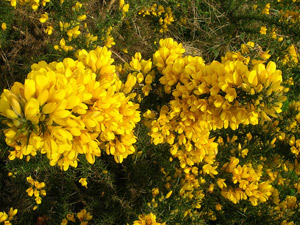When the neighbour’s gorse jumps the fence

Ulex (gorse, furze or whin). © Roger Griffith
If you’re in Southland and your neighbours gorse and broom is starting to cause you problems then it’s time you called Environment Southland.
In the South it is the organisation that all pest plant enquiries/complaints should be referred to. It doesn’t matter whether the land in question is private, public or Crown land.
Environment Southland, like other regional councils has a Pest Plants Management Strategy. Under this strategy gorse and broom are two plants that are designated as being “boundary control” pest plants.
Senior Biosecurity Officer Keith Crothers said that both gorse and broom are required to be kept a minimum distance of 10 metres away from any adjacent boundary fence or property.
“The philosophy of this rule is essentially that because gorse and broom are such widespread plants throughout the region, there is no likelihood of eradicating either of them.”
As such, property owners and/or occupiers can grow (or “virtually farm”) gorse and broom on their land so long as they do not impose their pest plant problem on neighbouring property that is clear of it.
“Accordingly, where two properties may have a common gorse or broom problem that spreads through and across a boundary, there is no requirement on either occupier to clear the pest plant infestation. Only when one of those properties is cleared, would the other part of the infestation be required to be cleared, and then, only the minimum distance of 10 metres from the boundary.
“The reason for the minimum distance of 10 metres being set is based solely on scientific evidence of seed dispersal. Both gorse and broom seed is spread ballistically from the seedpods exploding open and casting the seed on the ground. Numerous studies have found that close to 100% of the seed falls within 5 metres of the plant but to be safe Environment Southland doubled this when deciding on an appropriate boundary distance.”
Other “boundary control” examples from the Pest Plants Management Strategy are blackberry, nodding thistle and ragwort (all 50 metres), Darwin’s barberry (40 metres), and hemlock (10 metres).
While the Crown is not legally bound by the Biosecurity Act and any pest management strategies, Environment Southland has generally found over the years that the Crown is co-operative when it comes to pest plant problems that are causing concern to its neighbours.
In dealing with any of the situations described above, Biosecurity staff will initially approach the offending landowner and attempt to get the necessary boundary treatment done on a voluntary basis. Failing that, Environment Southland will implement its regulatory procedure whereby a Notice of Direction is issued to the occupier of the infested land requiring specific measures to be carried out.
“It is usual to give the occupier about one month to do the work. Should there be no compliance with the Notice of Direction, Environment Southland may elect to do the work itself and charge the occupier accordingly, as well as prosecuting the occupier,” Mr Crothers said.
There are substantial penalties that can be imposed by the Court for non-compliance with a Pest Management Strategy.
In most instances, staff will try and work alongside an occupier in an endeavour to get the work done within what is deemed to be reasonable amount of time given that many of the pest plant problems have probably been in existence for a considerable period before it was brought to Environment Southland’s attention.
Note: Farmers in other regions of New Zealand who are having problems with neighbouring pest plants should contact their local authority and ask for details of their Pest Plants Management Strategy.
Overall, in the last 30 years there has been increasing proportions of imports of naturalised plant species arriving from east Asia and South America, and a declining proportion from Europe.
The rate of entry of alien plant species into New Zealand, based on the time since European settlement and the size of the alien flora (domestic and naturalised), is about one species every two days, or 144 species per year.
Amongst these there are likely to be three to five potential new weeds.
Category: Environment, Focus

Hi I live in Oreti Street Invercargill and my neighbour has gorse hanging over my fence. Is it a plant I should ask him to get rid of?